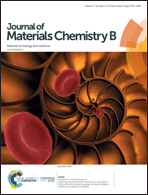FRET investigation toward DNA tetrahedron-based ratiometric analysis of intracellular telomerase activity†
Abstract
Telomerase catalyzes the elongation of telomeres, which is closely associated with tumorigenesis. Therefore, development of reliable and convenient methods for telomerase activity analysis is critical for clinical diagnosis of cancers. However, most of the current probes for intracellular telomerase activity assay suffer from inevitable false-positive interferences. In this study, we have proposed a novel fluorescence resonance energy transfer (FRET)-based strategy for ultrasensitive monitoring intracellular telomerase activity with an amplification-free procedure. DNA nanoprobes constructed using a DNA tetrahedron and Flare DNA are designed to circumvent the problem of false-positive interference. Generally, telomerase catalyzes DNA extension and changes the configuration of the DNA nanoprobe, which finally leads to the increase of the distance between two labelled fluorophores. Based on the notably decreased FRET efficiency, a simple ratiometric sensor is established for the detection of telomerase activity at the single-cell level, which is much suitable for clinical applications. In addition, this method can be further applied in the detection of telomerase inhibitors, which is important for anti-cancer drug discovery.



 Please wait while we load your content...
Please wait while we load your content...